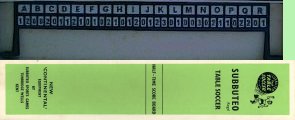
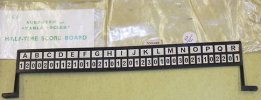
| Peter Upton's |
| Subbuteo Tribute Website. |
|
This second page of Continental accessories is a bit of a mixed bag. There are short-lived items such as the Subbuteo tie, and club flag, but it finishes with the first two cups, the European Competitions Cup, and the lovely Jules Rimet.
C111: Half-Time Scoreboard.
Another accessory to add realism to your stadium layout... contains "score cards".


This was a rather strange item. Half-time scoreboards were once common at football grounds, but I must admit they was a bit of a mystery to me when I started playing Subbuteo in 1979, aged ten. This item didn't perplex me for long however because its final catalogue appearance was 1980.
The set was available in three versions. The first version was introduced in 1965-66 at a cost of 2/11d. It was made from black plastic, and was shown in the 1960s brochures standing behind the fence surround. The scores on this version were fixed (it is just one long sticker), so it was only for show.


At some point in the late 1960s the scoreboard was changed to a version that clipped into the red fence surround. This version reduced the number of scores displayed (from 18 to 7), but supplied scorecards that could be cut out and slid into the board making it useable. The numbers are printed on both sides, so you have a decent range of options. The catalogues do not make it clear when the changeover occurred, but the best bet is 1969-70, when the price increased to 3/6d. However, scorecards were not mentioned until the following year (the 1970-71 catalogue rewrote a lot of item descriptions). Of course, 1970-71 was also the year that the green fence debuted, so it is possible that the red half-time scoreboard had a very short life.


With the arrival of the green fence came the final version of this board. This worked in exactly the same way as the red board by slotting into the fence and by having scorecards. The brown posts from the fence surround were often glued onto the ends of this item (but not always). One downside to this version is that there is no base under the cards to help hold them in place.
January 2025: Further investigation of the green half-time scoreboards has revealed an early variation, which is of longer length. This early board used the stickers from the red fence, instead of one single sticker but the differences do not end there. This was actually a different casting with eleven green post tops instead of the usual ten, and a reverse with an indent reminiscent of the green fence advertising boards. This seems very short lived. Did the extra length prove problematic when added to a full fence surround?
A big thank you to Ashley Hemming for spotting this extra version and provided the pictures. There are some fairly unlikely half-time scores on these boards, but I am reliably informed that on the real life version at the Goldstone Ground the kids in the crowd always moved all the cards about anyway!


The standard green fence version seems most common with green letters, but a red letter version has also been sighted, and is illustrated. These fences do still have individual indents for the A-G letters, but a single sticker covering the whole area obviously makes more sense for ease of production.


C112: Football Club Flag.
Mounted on pole and stand, the flag is available in red, white, blue, maroon, and old gold. Cut out adhesive sheets supplied showing individual teams of the English and Scottish leagues and a wide range of international teams.
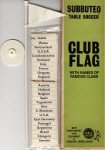
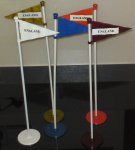
The flag arrived in 1965, and was another accessory to come in a long thin 1960s box. Unlike the half-time scoreboard and fence though, this did not have a lift-off lid, it was simply open ended. The flag itself was approx. 12 inches high, and the full range of colours is now shown above (thanks to Ashley Hemming)
Although the flag left the accessory range in 1972, it continued to feature in the big boxed editions of the mid 1970s, such as the Munich World Series and International Editions.
C113 (1965-66):
Football Club Flag
Mounted on pole and stand, the flag is available in red, white, blue, maroon, and old gold.
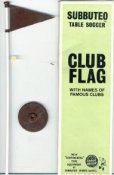
This set only appeared in the 1965-66 catalogue. It was just set C112 without the cut-out adhesive sheets, and cost 2s 4d, as opposed to 3s 11d for the full package. The stickers were also available separately as C114 in that catalogue. I guess if you wanted to buy several flags, you would only need one set of stickers to decorate them, so this set was logical. I have illustrated this item with the picture I previously used for C112, as this does not have the sticker sheets shown. However, the box clearly stated "with names of famous clubs", so there should be a C113 box without this line. This all seems a bit excessive, and SSG clearly had a change of heart. On the next year's price list (1966-67) the range dropped back to C112, and a new C113 was produced the following year (see below).
C113
(1967-80): Ambulance and Policeman Set.
Comprising 2 stretcher bearers, stretcher patient, and two policemen.

This set first appeared in 1967-68, and lasted until the 1980 catalogue after which it was replaced by the police squad (C159), and the first aid set (C184). There were two versions of the set produced, and the illustration above shows the difference between them. On the left of the stretcher is the 1960s set, which included two tall policemen on big green bases, and two small ambulance men on fixed square bases. This version was still illustrated in the 1972-73 catalogue. The new redesigned set (shown right) was first illustrated in the 1975-76 catalogue and continued until 1980. The detail here is much better, and the figures all look like they come from the same set.


These lovely pictures were from Ashley Hemmings. The first picture shows the two different versions of the stretcher bearers in action, with the older ones in the foreground. The difference between the two stretchers/patients should now also be obvious. Whilst the older version is clearly less detailed, the most distinctive difference is the two red stripes on the blanket. The second picture shows the policemen from the early set in both types of base.
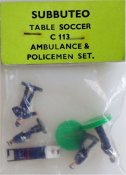
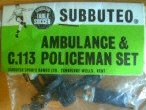
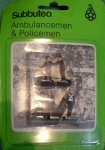
C114 (1965-66): Team
Sheets.
For use with the Football Club Flag.

As mentioned above, this original use of C114 only appeared in the 1965-66 catalogue. The adhesive sheets cost 1s 9d. Each team has two stickers, so that both side of the flag could be labelled. Like the scoreboard (Set Z/C115), the flag sheets for clubs were listed in league format. The First Division from 1965-66 is illustrated, and the fun thing about this is that it is the only year that Northampton Town have ever spent in the top flight of English football.
C114
(1967-77): Mascot and bench set.
Comprising mascot painted in England's colours, manager with two reserve players sitting on touchline bench.
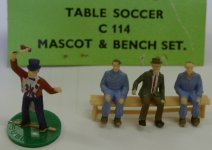
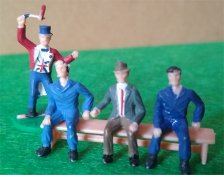
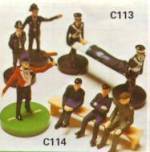
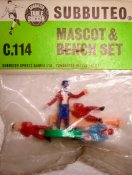
The mascot in the top hat is Ken Baily, who also appeared on the Football Express box. Somewhat unsurprisingly, there are variations to this set as well. The original set (shown left) was introduced in 1967-68, had a manager in a tie, and reserves in old style tracksuits. Ken Baily has his rattle in his right hand. The set was illustrated in the 1972-73 catalogue. There are actually a couple of different reserve figures, and looking at the pictures I have on file, you seem to get one type or the other, rather than one of each. There is one with both hands on his knees, and one with one hand away from the body (see the pictures). The reserves always seem to be painted in blue, but the tone varies from sky to dark.
The newer set featured much improved figures and was illustrated alongside the new C113 in the 1975-76 catalogue. Now there was one substitute with his arms crossed, and one with his legs crossed. This time out, the reserves could be painted in dark blue or red. The reserves can appear in green tracksuits in early editions of the Spectator set (C141), and I suppose it would make sense to have taken these from bench sets, but I've not actually seen this set in green. The manager in this later set had a cloth cap, and somehow reminds me of Bill Shankly. This figure originally appeared in the cricket deckchair sets, and the colour variations are the same as that set. That means he was usually in a sombre grey or brown suit, but sometimes he turned up in a lurid sky and red combo, as the sealed set above shows. In this second set, a thinner Mr Baily is waving his rattle in his left hand. Both versions of Ken are available in a pair of base variations - either thin and named, or thick and plain. The bench in the later set was also simplified. It no longer had a support bar underneath, and instead the legs were supported with triangular braces.
The bench set was replaced in 1976/77 by C139 which was the first outing for the more familiar clear plastic bench. That set originally featured the same bench occupants as the final C114 (sadly minus Ken).
C115: Subbuteo Tie.
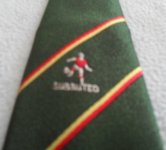
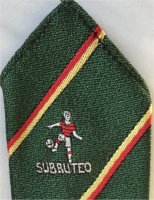
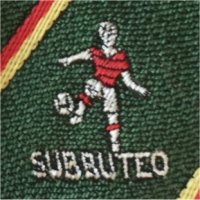
Isn't that just the greatest description? Introduced in 1967-68, this was a very short-lived item, with 1969-70 its final appearance. It is one of the few numbers to get reused. A few ugly Subbuteo ties have surfaced in Italy, but none match this description.
July 2013:- At last, the official Subbuteo
tie is illustrated in all its glory. Note the lovely old kicking footballer logo
(my favourite among them), and the moss green colour. This is just the best tie
ever. Well done to Ashley Hemmings, who sent this one in. It only took 14 years
to get this illustration!!
April 2023: Ashley has provided another picture of the tie, which allows some
close-ups. A lovely item... Isn't the footballer upside-down on this one though?
C115(Z): Match Score Recorder.
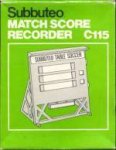
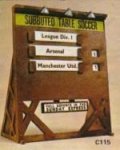
This was a sensible re-number of the lovely brown match scoreboard that had been introduced as a replacement Set Z in 1969. As the replacement flags of this vintage came straight into the Continental range, it does seem odd that this set did not get a new number on arrival. However, it did become C115 in 1973, and continued on that number until 1978. The catalogues used the "Z" suffix until 1977, probably because the set was still being sold in the original box. The letter was finally dropped with the "hobby crest" box produced in the late 1970s.
The scoresheets supplied normally just covered the English and Scottish leagues, and the home nations. However, World Cup team names were also issued from time to time on their own sheets, and foreign boards included appropriate teams. The British team names were in a single alphabetical list in the 1970s, which meant less updating than the old "League" format. However, changes did occur when necessary, with Hereford replacing Barrow, and Wimbledon appearing in the final sets.



The last issue of the board was a World Cup 1978 version with extra World Cup name cards printed in red. It was replaced in 1979 by the black stadium scoreboard (C158), which had large legs designed to display the board over the new terracing. There were also earlier red World Cup card issued for both 1970 and 1974. The 1970 set seems more uncommon, and I've not seen it in an individual boxed scoreboard, only in World Cup Editions, and surprisingly a 1974 Munich set. However, the detailed 1974 release did get issued with individual scoreboards. It is worth pointing out that the format for the 1978 World Cup was changed, and there was a second group stage rather than Quarter and Semi Finals.
C116: Car Sticker.
3in. diameter... in red, green and black on white vinyl, depicting a Subbuteo footballer motif. Suitable for sticking on cars, and bicycle saddlebags.
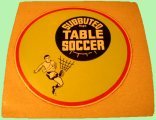
C116(C): Subbuteo Handbook.
A fully illustrated booklet of elementary and advanced rules for the experienced player, explaining the best methods of beating your opponent.
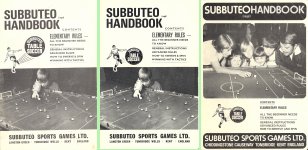
This item first appeared in the 1973-74 catalogue as C116C. The second "C" referred to item "C" in the old A-Z range, which switched across to this range in that year to fill in one of the unused numbers (along with C109M, and C115Z).
However, there was a difference between the two items. Although the price lists still called C116C the "Advanced Table Soccer booklet" until 1976, the catalogues were more accurate, as the description at the top of this section from 1973-74 shows. Under this reference, the basic rules, advanced rules, and the "spin!" booklet were all combined into one handbook. Of course, this was also the rule book in the boxed sets, so you only needed to buy C116 if your dog (or gerbil) ate the original.
This combined handbook had different rules in the basic and advanced sections, and this was pretty confusing to new starters (I should know, as I was one). So eventually the basic rules were split out again. The full handbook survived until 1981-82. Its replacement in 1983 was a "revised" handbook on ref C193. Like the original C116, this only had the more advanced tournament rules within it.
I have now illustrated three versions of the booklet. The first two (dated 1972 and 1973) are pretty similar, but you might see that the logo is slightly different. The early version still had the "Super Set" in the advert for boxed sets inside the front cover. The second version lost this, but gained the Munich Edition description. Both advertised Football Express on the back cover. The final version is the one I had as a kid. It had the Chiddingstone Causeway address, and the newer range of box sets (i.e. Stadium Edition). The basics were the same, but the advanced rules have been updated and lengthened. For example, the offside rule (rule 4) now had eleven points, instead of five. No wonder I was confused.
C117: Six Pitch Flags.
Four corner flags on bases with built-in ball raising recesses for improved corner kicks, and two halfway line flags.
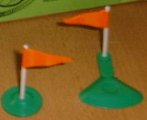
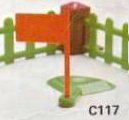
These were the big orange flags that also appeared in the box sets from the early 1970s, and of which there can't be many left that haven't been sat on and glued back together repeatedly. Oh joy. They made their debut in the big late 1960s catalogue, and on the 1969-70 price list. They were part of the first big expansion of the "C" range, where numbers C117-C126 all arrived at once. They replaced the flag set in the old range (Set T, with its metal posts), which was immediately dropped.
There were two versions. The original set (shown left) had a triangular orange flag on a white stick. A drawing of these appeared as "new" in the late 1960s catalogue. These had quite a short period of production, as by the time of the first illustrated price list (1972-73) they had been replaced by the much more common big square flags (shown right). The square flags were closer in look to the old Set T.
Both types of flag came on the same green bases. Whilst Set T was designed to push through the cloth (and therefore hide the bases), the plastic base sat on top of the pitch. Subbuteo's designers made this into a positive change by providing a ball-raising recess on the corner flags, to make lofted corners much easier. The flag itself was then on a thin bar, so as not to interfere with the player taking the corner. I have been advised that this worked really well, as long as you were willing to stick the base down (blu-tac would do). When not taking corners, the flag could be turned around, so that the base did not encroach onto the field (unless you'd stuck it down....).
As I've already mentioned, the flags soon found their way into the boxed editions of Subbuteo from the Club Edition upwards. Room was made for them below the pitch in the early 1970s sets. As most kids had to play Subbuteo on the floor, and as the flags were near the edges of the pitch, most quickly broke, and it is hard to find sets with the full compliment of flags.
The big flags reign came to an end when a set of smaller flags (that were even more prone to being sat on) was introduced in 1981 as C188. The old faithful C117 kept going in tandem with the new for a couple of years, but 1983 saw them dropped to the "order only" accessory list, and that was the last we saw of them (and they left the box sets at the same time).

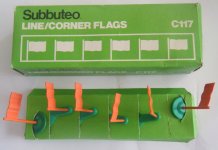

C118: European Competition Trophy.
C119: Jules Rimet World Cup.


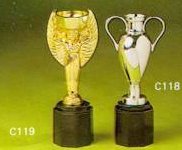


These two cups arrived in 1969, and were the first in an intermittent series of replica trophies. Obviously not in any Subbuteo scale, these sets are basically designed to look nice on a shelf in your games room (you don't have a games room?) The original boxes folded so you could display the cups within them, and had nice coloured inserts to make the cups stand out.
The Subbuteo book Flick to Kick mentions a full size World Cup sculpted for Subbuteo by Dave Pomeroy, which was to be scaled by their head draughtsman, Keith Buckwell. The tale goes that when the World Cup was stolen, Mr Buckwell put their full sized copy in the window of the Subbuteo offices with a "for sale" sign, which resulted in a police raid. The real cup was stolen in March 1966, so this story suggests that Subbuteo were aiming to release their version for the 1966 campaign. However, it was actually released later than that. We turn once again to Charles Stadden's invoices for further insight into the design process.
08/03/67: Replica of the World Cup carved in tin alloy. Size of figure and cup 3 3/8". Steel spigot set under base to fit in plinth. £45.10s Plinth carved in wood octagonal, 8 sides, recessed top. Eight plates, one to each of the sides. £8.10s European Cup, carved and engraved, separate plinth. £35
The European Cup (C120) is another item that needs a little explanation. The one produced by Subbuteo was the smaller version held aloft by Real Madrid countless times in the late 1950s. However, by 1967 (and Celtic's win) the cup had already changed to the design still handed out today to the Champions League winner. Mind you, even the Observer's Book of Football of the 1970s still showed this old trophy, so perhaps we can forgive the error. I wonder how many of us bought it in the 1970s/1980s thinking it was the European Championship trophy.
The later style of European Cup finally arrived as C204 in 1983.
Both these cups survived right through the "Continental" number era, with the European Competitions Cup bowing out in 1983, just missing a 61xxx number. However, the Jules Rimet did hang on until 1984 to briefly become 61119.This may seem surprising as the Jules Rimet was, of course, won outright by Brazil in 1970 and all subsequent World Cups have used a different trophy. I guess the Jules Rimet's survival was down to its attractiveness, plus the fact that England won it in 1966. That match must've been replayed in miniature ever afterwards. Either that, or the stock sold very slowly.... Interestingly, the new style World Cup only turned up in time for the 1982 championships (as C182) - and even then it didn't succeed in out lasting the Jules Rimet - both were removed in 1984.
Actually, Subbuteo have a run of bad luck on their cups. This started with the original European Cup not being the version won by Celtic or Manchester United. Then the Jules Rimet was won outright one year after Subbuteo produced it. Then the League Cup was produced just before the Milk Cup replaced it, and the corrected European Cup was produced just as English sides were being chucked out of Europe. Sad, but true.
Also strange. The Jules Rimet is obviously referred to as "the World Cup" in the early catalogues, until 1974 when it needs to be differentiated from the new version. In the 1974 catalogue, there is a star next to this item, and at the bottom of the list it says "* - Jules Rimet version - limited stocks only". Obviously not that limited.....
C120: Footballer Statuette.
On a plinth in all club colours.



This set was introduced alongside the two cups in the 1969 catalogue. Charles Stadden invoiced for a 3" statuette of footballer about to kick the ball. Carved and engraved in whitemetal (tin alloy)" two weeks before his invoice for the World Cup shown above, so this lovely figure must be his work.
The statuette came in the same design of box as the cups, with a similar insert. The nice original catalogue illustration (shown middle, above), suggested that the Cup plinth would be used, but in fact the player received a short round plinth instead (as shown in the photo). This obviously helped with stability.
The statue could be hand-painted in any of the club colours on the team lists. As it survived in the catalogues until 1975-76, (being removed in the 1977 purge), this suggests that it could be painted in any team colours up to reference 190. However, the unsold stock of this item floating around the Subbuteo collecting community suggests that the more common range would be that of 1971-72, which was 1-81 plus the 1970 World Cup sides (later added to the team range between 150 and 166). The 1971-72 catalogue does stress that new teams 76-81 are available under C120, and a separate 1970 World Cup flyer advised that "teams and statues" were available in the named box range.
However, a few later reference numbers have been sighted, the most common being ref 93 Roma. I have also seen the "named box" Derby County in statue form (shown on the Team odds and ends page).
I would suggest that if the early numbers were only selling slowly, the later ones would have been painted by request only. I could be wrong though. I originally suspected that shops would only keep a few popular teams in this format, but Chris McKay remembers his local stockist in Edinburgh having all the major Scottish teams in 1971. So anything is possible.
This seems a good point to take a break, the page having already grown rather long. If you wish to push on deep into the heart of the 1970's, then you can follow the links laid out below.
[ Main Page | Previous Page | Next Page ]